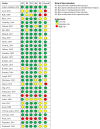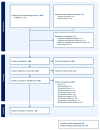Non-Invasive Telemonitoring in Heart Failure: A Systematic Review
- PMID: 40731906
- PMCID: PMC12299789
- DOI: 10.3390/medicina61071277
Non-Invasive Telemonitoring in Heart Failure: A Systematic Review
Abstract
Background and Objectives: Heart failure (HF) represents a major public health challenge worldwide, with rising prevalence, high morbidity and mortality rates, and substantial healthcare costs. Non-invasive telemonitoring has emerged as a promising adjunct in HF management, yet its clinical effectiveness remains unclear. Materials and Methods: In this systematic review, we summarize randomized controlled trials (RCTs) between 2004 and 2024 examining the efficacy of non-invasive telemonitoring on mortality, readmission, and quality of life (QoL) in HF. In addition, we characterize the heterogeneity of features of different telemonitoring interventions. Results: In total, 32 RCTs were included, comprising 13,294 participants. While some individual studies reported benefits, non-invasive telemonitoring demonstrated mixed effects on mortality, readmission rates, and QoL. The most common modality for interfacing with patients was by mobile application (53%), followed by web portals (22%), and stand-alone devices (19%). Periodic feedback (63%) was more common than continuous feedback (31%) or on-demand feedback (6%). Clinician reviews of patient telemonitoring data was event-triggered (44%) more commonly than based on a prespecified timeline (38%). In most designs (90%), patients played a passive role in telemonitoring. Conclusions: Non-invasive telemonitoring interventions for HF exhibited considerable variation in duration and system design and had a low rate of patient engagement. Future work should focus on identifying telemonitoring-responsive subgroups and refining telemonitoring strategies to complement traditional HF care.
Keywords: heart failure; mortality; quality of life; readmission; telemonitoring.
Conflict of interest statement
The authors declare no conflicts of interest.
Figures
Similar articles
-
Effects of home telemonitoring interventions on patients with chronic heart failure: an overview of systematic reviews.J Med Internet Res. 2015 Mar 12;17(3):e63. doi: 10.2196/jmir.4174. J Med Internet Res. 2015. PMID: 25768664 Free PMC article.
-
Structured telephone support or non-invasive telemonitoring for patients with heart failure.Cochrane Database Syst Rev. 2015 Oct 31;2015(10):CD007228. doi: 10.1002/14651858.CD007228.pub3. Cochrane Database Syst Rev. 2015. PMID: 26517969 Free PMC article.
-
Home telemonitoring or structured telephone support programmes after recent discharge in patients with heart failure: systematic review and economic evaluation.Health Technol Assess. 2013 Aug;17(32):1-207, v-vi. doi: 10.3310/hta17320. Health Technol Assess. 2013. PMID: 23927840 Free PMC article.
-
Home telemonitoring and remote feedback between clinic visits for asthma.Cochrane Database Syst Rev. 2016 Aug 3;2016(8):CD011714. doi: 10.1002/14651858.CD011714.pub2. Cochrane Database Syst Rev. 2016. PMID: 27486836 Free PMC article.
-
Effectiveness of telemonitoring on self-care behaviors among community-dwelling adults with heart failure: a quantitative systematic review.JBI Evid Synth. 2021 Oct;19(10):2659-2694. doi: 10.11124/JBIES-20-00329. JBI Evid Synth. 2021. PMID: 33896907 Free PMC article.
References
-
- Bozkurt B., Coats A.J., Tsutsui H., Abdelhamid M., Adamopoulos S., Albert N., Anker S.D., Atherton J., Böhm M., Butler J.D., et al. Universal Definition and Classification of Heart Failure: A Report of the Heart Failure Society of America, Heart Failure Association of the European Society of Cardiology, Japanese Heart Failure Society and Writing Committee of the Universal Definition of Heart Failure. J. Card. Fail. 2021;27:387–413. - PubMed
-
- Roth G.A., Dorsey H., Decleene N., Razo C., Stark B., Johnson C. The global burden of heart failure: A systematic analysis for the Global Burden of Disease Study 2021. Eur. Heart J. 2023;44((Suppl. 2)):ehad655.876. doi: 10.1093/eurheartj/ehad655.876. - DOI
-
- Bozkurt B., Ahmad T., Alexander K., Baker W.L., Bosak K., Breathett K., Carter S., Drazner M.H., Dunlay S.M., Fonarow G.C., et al. HF STATS 2024: Heart Failure Epidemiology and Outcomes Statistics An Updated 2024 Report from the Heart Failure Society of America. J. Card. Fail. 2025;31:66–116. doi: 10.1016/j.cardfail.2024.07.001. - DOI - PubMed
Publication types
MeSH terms
LinkOut - more resources
Full Text Sources
Medical
Research Materials
Miscellaneous



